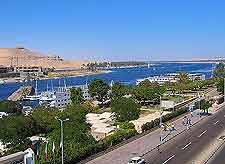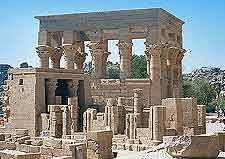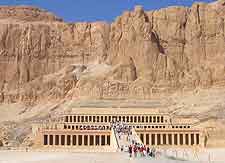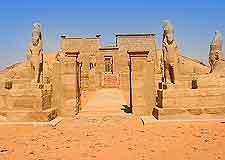Attractions Nearby Abu Simbel, Day Trips and Excursions
(Abu Simbel, Egypt)

Many tourists choose to visit southern Egypt and tour the main attractions, of which are temples of Abu Simbel are particularly enthralling. Abu Simbel is well-placed to explore many other wonderful Egyptian attractions and wonders, a number of which can be visited as day trips, although do be prepared for an early start so that you can make the very most of your excursion, particularly if you intend to sightsee in
Aswan and around the famous
Aswan High Dam and Lake Nasser.
Luxor has long been one of the most popular excursions from Abu Simbel, although this journey is too far to make a day trip possible. The attractions of Luxor are best reached by taking a bus or private car (air-conditioned) to Aswan, and then travelling by train all the way to Luxor station.

Aswan
The ancient city of Aswan boasts a number of wonderful Egyptian attractions and lies around 280 km / 174 miles north of Abu Simbel. Most tourists intending to visit Aswan reach this city via a convoy of buses, with the total journey time taking a minimum of three hours. The attractions of Aswan are quite diverse and comprises much more than just temples, with popular activities such as camel riding and cruises along the River Nile, aboard a traditional Egyptian 'felucca' sail boat. However, the rich Nubian history on the city's Elephantine Island and Kitchener's Island is a true pinnacle of any visit, as is the
Philae Temple, the Tombs of the Nobles, and the Unfinished Obelisk, which remains in place in the ground, only partly completed and abandoned after a crack appeared in the granite.

Luxor
Although it is a fair old trek to reach Luxor from Abu Simbel, tourists will usually find the journey more than worth the effort, especially when they are greeted with the grandeur of ancient Thebes. Many truly world-class attractions and Egyptian treasures await in the city of Luxor, within the Nile Valley. Highlights include the
Colossi of Memnon, the Temple of Deir El-Bahri, the
Temple of Karnak, the Temple of Merneptah, the Valley of the Kings and the Valley of the Queens. The Avenue of the Sphinxes is especially breathtaking, while of particular interest, the Temple of Luxor was constructed by both King Amenhotep III and also King Ramesses II, to be used in the celebrations at the Festival of Opet.

Wadi El Sebua
Wadi El Sebua is to be found relatively close to Abu Simbel and around 140 km / 87 miles directly south of the famed High Aswan Dam. The Temple of Wadi al-Sabua (Wadi el-Sebua) was historically named the 'House of Amun' and salvaged in 1964, being moved to its present setting, high above the waters of the man-made Lake Nasser. Attractions at Wadi El Sebua include many magnificent statues of human-headed sphinxes and beautiful, ancient hieroglyphics. Unfortunately, the neighbouring Temple of Amenhotep III was no so fortunate and now resides at the bottom of Lake Nasser, although many relics and treasures from this temple now reside within the Aswan Museum.
New Kalabsha
New Kalabsha lies alongside the Aswan High Dam and directly to the south of the city of Aswan. The main attraction here is the Kalabsha Temple, a famous Nubian monument which was carefully relocated here in 1970, before the Aswan High Dam was completed. A major operation, the Kalabsha Temple originally stood just 25 km / 16 miles from its current site and is amongst Egypt's biggest free-standing temple. Transported piece by piece, the temple was painstakingly cut into no less than 13,000 different blocks, and today looks like it has been standing here all of its very long life.
 Many tourists choose to visit southern Egypt and tour the main attractions, of which are temples of Abu Simbel are particularly enthralling. Abu Simbel is well-placed to explore many other wonderful Egyptian attractions and wonders, a number of which can be visited as day trips, although do be prepared for an early start so that you can make the very most of your excursion, particularly if you intend to sightsee in Aswan and around the famous Aswan High Dam and Lake Nasser.
Many tourists choose to visit southern Egypt and tour the main attractions, of which are temples of Abu Simbel are particularly enthralling. Abu Simbel is well-placed to explore many other wonderful Egyptian attractions and wonders, a number of which can be visited as day trips, although do be prepared for an early start so that you can make the very most of your excursion, particularly if you intend to sightsee in Aswan and around the famous Aswan High Dam and Lake Nasser.

